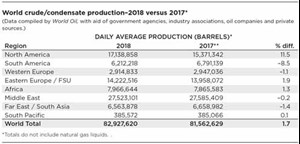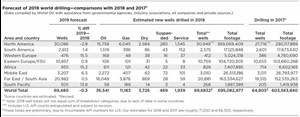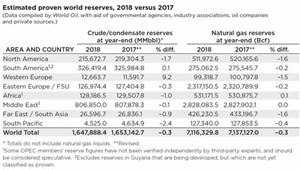E&P activity outside the U.S. to continue moderate growth
Considering the above factors, our updated forecast calls for worldwide drilling to decline 2.4% during 2019, to 69,480 wells, from an estimated total of 71,203 wells in 2018 (based on World Oil’s estimates beyond API actuals, to date.) If the U.S. and Canada are left out of the equation, we project a 1.8% increase in drilling in the rest of the world.
We forecast that the world’s top four drilling countries will be, in order, the U.S. (24,653 wells), China (19,425 wells), Russia (9,705 wells) and Canada (5,220 wells). Together, these four nations will drill 59,003 wells, or 84.9% of all drilling worldwide. This compares to an 85.7% share in 2018 and an 85.4% share in 2017.
Worldwide oil production gained 1.7% to average 82.928 MMbpd, spurred by a 17.2% increase in U.S. oil output. Although Russia remained the number-one oil producer during 2018 at 11.072 MMbpd, the U.S. sailed past Saudi Arabia to become the number-two at 10.962 MMbpd. Saudi Arabia slipped to third place, averaging 10.300 MMbpd. Worldwide oil and gas reserves were nearly flat, losing just 0.3%, each, during 2018 and totaling 1.648 trillion bbl and 7,116.3 Tcf, respectively.
NORTH AMERICA
The U.S. will drill 35.5% of all wells globally, down from 36.0% in 2018. U.S. drilling activity is predicted to wane in the second half of 2019, as production and financial returns from the shale plays disappoint investors. Also, the growing number of DUCs further indicates that a reduction in activity is prudent, to focus on completing idle wells to recoup investments, rather than loading more orphans in the queue. (See page 47 for the complete U.S. forecast.)
Canada. Widening crude pricing differentials and a year-over-year rig count decline of 39% (as of late August) led to a decrease in E&P spending projections for 2019, versus a 5% increase during the previous year. Reflecting the troubled Canadian E&P sector, drilling is forecast to decline for a second consecutive year, losing 21.4%. Given these headwinds, Canadian crude and condensate output is not likely to show an increase during 2019, compared to the 7.2% gain achieved during 2018.
Alberta has elected to extend its production curtailment program through the end of 2020, continuing its efforts to assist domestic energy companies, particularly independents. Under the program, the base limit for curtailment will double to 20,000 bpd in October, with the government also pledging to provide 60 days’ notice for any further adjustments. These changes are expected to reduce the numbers of producers affected by the program, while helping smaller producers plan investments. Accordingly, the Alberta government has raised the October production limit to 3.79 MMbopd, with curtailments reduced approximately 70% from the initial January level. As part of this new limit increase, smaller producers will not be able to transfer their production to other companies.
The production curtailment program was initially designed to address a shortage of crude transport capacity, which stands 150,000 bopd short of daily requirements. It remains to be seen whether the Canadian government will commit further to providing logistical support to upstream providers. For more details on Canadian E&P, please turn to page 55.
Mexico. Uncertainty continues to surround Mexican president Andres Manuel Lopez Obrador’s ultimate plans for the country’s oil and gas industry. Little progress shows for PEMEX’s turnaround, despite securing tax relief measures and an $8 billion loan from the government in May, in an effort to improve production in the short term.
The state-run company aims to balance its budget by 2021, with a commitment to invest 1.95 trillion pesos ($102 billion) to focus on shallow-water and onshore exploration opportunities by 2024. Mexico’s proven oil reserves have fallen 77% in the past two decades, and the risk remains that the government’s decision to freeze lease auctions and joint ventures may hinder output growth further.
PEMEX has routinely failed to meet its production targets, with current output now just 53% of its peak level of 3.476 MMbopd in 2004. Daily average production declined 6.5% in 2018.
SOUTH AMERICA
Following a year of substantial growth in 2018, when E&P spending growth reached 19% year over year, spending and associated growth are expected to level off. Venezuela’s PDVSA continues to negatively impact regional production totals, while new shale discoveries in Argentina and deepwater finds offshore Guyana serve as bright spots that offer significant potential for future growth. Accordingly, we project regional drilling to increase 1.4% in 2019. Overall, production in South America fell 8.5% to 6.2 MMbpd.
Argentina. The Vaca Muerta shale play is an opportunity for Argentina to potentially become an important player in the international LNG market. YPF awarded FEED contracts for LNG liquefaction and export facilities, and Excelerate Energy was chartered to provide LNG carrier services. Meanwhile, nationwide drilling was up 2.5% in 2018, and should be up another 5.5% this year. Production of crude and condensate increased 2%. IOCs continue to show interest in exploring the Vaca Muerta further, as well as select shallow-water opportunities.
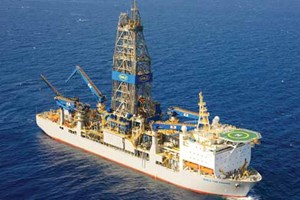
Bolivia. Production-sharing laws introduced in 2005 and 2006 that require all production to be sold to state-run YPFB, while paying 50% of gross production in taxes and royalties, continue to slow investment in the country. The results of these regulations, along with a decline in proven reserves, have led the Bolivian government to begin to issue incentives and exemptions to encourage investment. Accordingly, drilling may be up this year. Production change was essentially flat.
Brazil. Offshore production by Petrobras and IOCs is poised to drive growth, particularly in the pre-salt formations of the Santos basin. In the short term, discussions on establishing oil and gas blocks in promising pre-salt locations beyond Brazil’s Exclusive Economic Zone have been tabled until 2020. These fields have the potential to increase Brazil’s proven reserves by as much as 50%. Drilling has slowed in the meantime. Total production declined 1.3%, to 2.59 MMbopd.
Venezuela. Sanctions against the Venezuelan government, which significantly impact state firm PDVSA’s operating budget, are not helping production figures suffering from inadequate field maintenance. Oil exports continue to fall, as Chevron begins planning an exit from the country in the event the U.S. fails to extend sanction waivers beyond Oct. 25. Total production declined more than 26%, to the lowest level that Venezuela has seen in decades.
Guyana. With the arrival of the Liza Destiny, Guyana’s first FPSO, production from the 6.6-million-acre Starbroek Block is set to begin during first-quarter 2020. Partners ExxonMobil, Hess and Production Guyana Limited will see the FPSO produce up to 120,000 gross boed, rising by 2025 to roughly 750,000 boed. ExxonMobil logged its thirteenth discovery on the Starbroek Block with its Yellowtail-1 well in April with Noble Tom Madden, Fig. 1., and is evaluating plans to add another exploration drillship to expand development drilling operations.
WESTERN EUROPE
Spending in Western Europe is anticipated to continue to rise, as new technologies extend the lives of producing fields, and new regional operators emerge to acquire assets from the legacy majors. In addition to activity related to existing fields (including increased P&A activity), 90 new exploration blocks will be auctioned in licensing rounds this year, 37 in the Norwegian Sea and 48 in the Barents Sea. Operators are demonstrating meaningful interest in these auctions, with the most recent APA 2019 offerings attracting applications from 33 companies. We project an increase of 15.5% in the number of new wells drilled across the region in 2019. Production across Western Europe, as a whole, declined 1.1%, to 2.9 MMbpd.
Norway. Activity in Norway extends its positive 2018 trend, with Statistics Norway increasing its estimates for field development, exploration and pipeline spending to imply 17% growth for 2019. Much of this increase can be attributed to the Snefrid Nord field coming online for Equinor in August, and Utgard and Johan Sverdrup fields projected to start production in September. Equinor has further committed to extending the life of eight of its installations on the Norwegian Continental Shelf to 2031, with plans to increase that number to 20. Drilling is up 3.0% this year. Production declined 6.2%.
United Kingdom. The UK’s oil and gas production increased 9% from the previous year, exceeding the Oil & Gas Authority’s earlier estimates. Increases in production efficiency, stabilization of operating costs, and EOR projects coming online are credited with this performance improvement. Additionally, more than 30 new onshore and offshore fields have come online since 2015. Drilling is up noticeably.
Decommissioning activity continues to increase, with expenditures reaching GBP 1.45 billion in 2018. Bucking this trend, smaller operators are taking on fields that are no longer commercially viable for supermajors and extending their productive life. UK-based Ithaca Energy demonstrates the effectiveness of this approach, acquiring Chevron’s North Sea assets for $2 billion, improving their proven plus probable reserves by 150% in the process. The life-extension strategies of regional operators acting as private equity-backed independents could meaningfully improve UK production rates for the next several years, slowing an eventual decline.
EASTERN EUROPE / FSU
Russia and the FSU continue to increase production by maximizing the potential of aging assets, while developing onshore, Arctic and unconventional resources. Similar approaches are poised to bear fruit elsewhere in Eastern Europe, as new seismic data and EOR techniques reveal remaining potential in legacy onshore fields. Increased production across the region, led by Russia and other FSU countries, contributed to a production increase of 1.9% to 14.2 MMbpd across Eastern Europe. We project an increase of 0.9% in the number of wells drilled across the region.
Russia. While its role as an OPEC+ member obliges the country to follow the production cuts of its peers, Russia has a history of its activities not aligning with its commitments. Production routinely exceeded numbers agreed to in its output-cut deals, only reaching them in May when international buyers refused to take crude from the Druzhba pipeline to Europe, due to product contamination. Future increases in oil production will require replacement of older fields via successful investment in new discoveries. In total, Russian production increased 1.7%. Drilling is expected to inch up 1.0% for 2019.
Natural gas production continues its steady increase, from a low of 611 Bcm in 2015 to 695 Bcm in 2018. Several ambitious gas drilling and LNG export projects are being pursued as part of the country’s goal to become a dominant player in the global LNG market. Rosneft recently announced plans to build a Far-Eastern export facility with its Sakhalin-1 partner, and Novatek approved a final investment decision on its $21-billion Arctic LNG 2 plant on the Gulf of Ob. Combined, these two projects will be capable of exporting ~26 MM tons of LNG per year, effectively doubling Russia’s export capacity.
Other FSU countries. The bulk of drilling activity continues to be in Azerbaijan, Kazakhstan and Turkmenistan. Meanwhile, key officials from the U.S., Estonia, Latvia and Lithuania are exploring the creation of a uniform natural gas market within the region. Under the umbrella of the Partnership for Transatlantic Energy Cooperation, the 3 + 1 Forum will explore opportunities to participate in the broader European energy network, particularly in the areas of natural gas and LNG. Total production between the FSU countries increased nearly 3%.
AFRICA
Steady growth across the continent, including meaningful production increases in Libya and Congo, contributed to a production increase of 1.3% to 7.97 MMbpd. Capital expenditures in Africa are projected to reach $200 billion by 2025. Several large LNG programs have been sanctioned, including BP’s $17-billion Greater Tortue Ahmeyim and Eni’s $7-billion Coral South FLNG development offshore Mozambique. Leading the drive to develop new production, Malaysia’s Petronas is expanding its presence in Gabon with the first new exploration permit that the country has issued in five years. We project a 15.2% increase in the number of wells drilled in 2019.
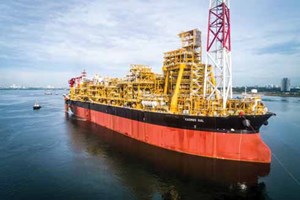
Angola. The government of Angola is reorganizing state oil company Sonangol, and revising oil and gas legislation to spur growth. Chevron and ExxonMobil account for nearly a third of the country’s production figures, and the government hopes these measures will encourage other multinational firms to invest in large offshore projects. Total is pursuing its $16-billion Kaombo ultra-deepwater project, targeting peak production of 230,000 bopd, Fig. 2, and BP is investing $14 billion in its offshore “Pluto, Saturn, Venus and Mars” (PSVM) operation. Drilling will be up 29%.
The recent drop in oil price and limited foreign currencies in Angola have hindered investment in new or mature fields, however, and these shortfalls are reflected in production falling 6.5%.
Nigeria. Newly-appointed head of the Nigerian National Petroleum Company, Mele Kiyari, is confident that repairing sabotaged pipelines that have stranded production across the Niger Delta will boost production to at least 2.5 MMbpd in 2020. Output has gradually risen since the middle of the decade, as militant campaigns against oil and gas infrastructure declined. Despite these improvements, oil theft claimed about 120,000 bpd of crude in first-half 2019, according to a government committee.
Nigeria plans to receive a final investment decision from Total on Preowei field next year, and a decision on Shell’s Bonga Southwest project is expected by the end of this year. Combined, these two projects could add at least 200,000 bpd to Nigeria’s production figures. Total production increased 1.9% during 2018. Drilling is up slightly this year.
MIDDLE EAST
While OPEC+ production cut commitments and tensions around critical shipping lanes capture most of the headlines around Middle East oil and gas activity, state-owned operators around the region are adapting to new political and economic realities. New export pipelines are being constructed to avoid conflict zones, offshore drilling continues apace, and long-term supply contracts are being signed to lock in still-depressed OCTG pricing. Production across the region was nearly flat, declining 0.2% to 27.5 MMbopd, which can be attributed in part to adherence to the November 2016 OPEC+ agreement to cut production by 1.3 MMbpd, in a bid to stabilize global crude prices. World Oil projects a 6.5% increase in the number of wells drilled in the region in 2019.
Saudi Arabia. In a move anticipated to improve relationships with other OPEC+ members, especially Iran and Kuwait, the Saudis named Prince Abdulaziz bin Salman, half-brother of Crown Prince Mohammed bin Salman, as the kingdom’s new oil minister. Whereas the former minister was also chairman of Saudi Aramco, the company is now led by the head of the sovereign wealth fund, and another minister is responsible for the industrial portfolio.
Saudi Aramco is in the final stages of preparations for its IPO and has issued $12 billion in bonds to pursue its new economic agenda as a publicly traded company. Development work continues, buying Schlumberger’s Middle Eastern drilling rig business in April and awarding several EPCI contracts for offshore field development, fabrication facilities, and new technology centers. The company is also expanding capacity of a crude export pipeline that will deliver 5 to 7 MMbpd to a Red Sea terminal, enabling shipping traffic to avoid the Strait of Hormuz. Total production increased roughly 1%, and drilling is flat this year.
UAE-Abu Dhabi. ADNOC continues to work toward executing its 2030 Growth Strategy, seeking to increase crude oil production capacity to 4 MMbpd by 2020, and 5 MMbpd by the end of 2030. To achieve this, bidding rounds for several onshore and offshore exploration blocks covering more than 34,000 km2 were launched this summer. The company has also kicked off the industry’s largest ocean-bottom nodal seismic survey, covering some 20,000km2 of offshore prospects. ADNOC has also implemented a procurement program that locks in OCTG commitments with key suppliers to deliver one million metric tons of casing and tubulars over the next five years to support drilling activities. Production increased 1.3%, while drilling is
up slightly.
FAR EAST/SOUTH ASIA
Spending in some Far Eastern and South Asian countries is projected to increase 17% from 2018 levels, with gas demand the primary driver behind that trend. China and Malaysia are bright spots in a region that saw overall production decline 1.4% to 6.56 MMbpd. In 2019, World Oil forecasts that wells drilled will remain nearly flat, with Chinese activity being barely up this year.
China. In the first half of 2019, CNOOC booked 16 new discoveries, and drilled 35 new appraisal wells, including the Bozhong 19-6 condensate gas field in Bohai, China. The field proved in-place volumes exceeding 100 million tons of oil equivalent. CNOOC has also targeted a 60% expansion of oil and gas production from the South China Sea in the next six years, as part of a plan to double reserves and develop as many as six new prospects by 2025. The Chinese government is also creating a national pipeline operator to break a domestic monopoly, which is projected to reduce in-country gas prices by 10% and spur 13% domestic consumption growth.
China’s ongoing trade dispute with the U.S. remains a wild card for import demand; the first-ever tariff on American crude imports was imposed in August of this year. Domestic production increased 0.1%, to 3.72 MMbpd. Drilling will be up again, rising 1.5 %.
Malaysia. Murphy Oil divested its Malaysian subsidiaries to state-run PTTEP for $2.1 billion, comprising 129 MMboe of proved reserves and 70 MMboe of proved, undeveloped reserves. Malaysia also recently closed an exploration licensing round for six new offshore blocks. We forecast an 11.7% decline in drilling in 2019, while production increased 0.1% in 2018.
SOUTH PACIFIC
Production in the region is flat, at just above 385,000 bpd, but regulatory changes and export startups in Australia have the potential to positively impact that volume. An increase of 13.8% in wells drilled across the region in 2019 is projected.
Australia. The country awarded an Environmental Management Plan for onshore shale gas exploration to Santos in the McArthur basin, the first such approval since a moratorium was lifted in 2018. The U.S. Energy Information Administration projects that Australia will surpass Qatar as the world’s largest LNG exporter, as newly-commissioned projects ramp up and operate at full capacity. Shell announced the first shipment from it’s Prelude FLNG facility off Western Australia, helping to expand the country’s total export capacity to more than 11.4 Bcfd in 2019. Total crude and condensate production in Australia rose 7.9%, and drilling is slated to gain 13.3% this year.
Papua New Guinea. The new prime minister, James Marape, took office in May amid concerns that changes would be made to natural gas export projects that ultimately led to the resignation of his predecessor, Peter O’Neill. Following some new economic commitments by Total, and a plan for new resource laws to relieve the state of expensive loan structures, the decision was made to move forward with the $13-billion agreement. Overall, production declined 11.7%, while drilling remains at a low level. WO
- Advancing offshore decarbonization through electrification of FPSOs (March 2024)
- U.S. oil and natural gas production hits record highs (February 2024)
- What's new in exploration (November 2023)
- What's new in production (October 2023)
- FPSO technology: Accelerating FPSO performance evolution (September 2023)
- What's new in production (August 2023)
- Applying ultra-deep LWD resistivity technology successfully in a SAGD operation (May 2019)
- Adoption of wireless intelligent completions advances (May 2019)
- Majors double down as takeaway crunch eases (April 2019)
- What’s new in well logging and formation evaluation (April 2019)
- Qualification of a 20,000-psi subsea BOP: A collaborative approach (February 2019)
- ConocoPhillips’ Greg Leveille sees rapid trajectory of technical advancement continuing (February 2019)

